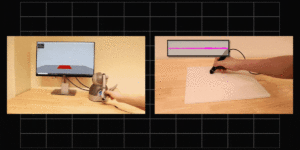
BRINGING THE SENSE OF TOUCH TO VIRTUAL REALITY EXPERIENCES COULD AFFECT EVERYTHING FROM SURGICAL ROBOTS TO ONLINE SHOPPING. IMAGE/MADELIN LUM.
With the spread of the Omicron variant, not everyone can or is eager to travel for the winter break. But what if virtual touch could bring you assurance that you were not alone?
At the USC Viterbi School of Engineering, computer scientist and roboticist Heather Culbertson has been exploring various methods to simulate touch. As part of a new study, Culbertson a senior author on this study, along with researchers at Stanford, her alma mater, wanted to see if two companions (platonic or romantic), could communicate and express care and emotion remotely. People perceive a partner’s true intentions through in-person touch an estimated 57% of the time. When interacting with a device that simulated human touch, respondents were able to discern the touch’s intention 45% of the time. Thus, devices in this study appear to perform with approximately 79% accuracy of perceived human touch.
Our sense of touch is unique. In fact, people have a “touch language” says Culbertson, the WiSE Gabilan Assistant Professor and Assistant Professor of Computer Science and Aerospace and Mechanical Engineering at USC. Thus, she says, creating virtual touch that people can direct towards their loved ones is quite complex—not only do we have differences in our comfort with social touch and levels of “touchiness” but we also may have a distinct way of communicating different emotions such sympathy, love or sadness. The challenge for the researchers was to create an algorithm that can be flexible enough to incorporate the many dimensions of touch.
Their study, which appears in pre-print in IEEE Transactions on Haptics was completed in two phases. First, a novel dataset was created about individuals’ interactions through social touch, by capturing the location and pressure of touches applied while participants communicated different emotions through touch to their partners. Once this dataset was created, the researchers then classified these gestures as communicating attention, gratitude, happiness, calming, sadness, or love to create a library of pre-recorded signals.
These signals were then translated into tactile pixels (taxels) that could communicate emotion with a second group of participants via a wearable haptic armband that included coil actuators with eight points of touch.
Overall, 661 touch gestures were recorded. About 45% of the time, individuals wearing the armband were able to understand the intended emotion communicated via remote touch (compared to only 57% of the time of in-person touch). The study proves that the social meaning and expression conveyed through in-person touch can be communicated remotely.
The next step for the researchers will be to customize the algorithms to generate a more refined sense of virtual touch for improved accuracy.
Says Culbertson, “While the physical divide caused by the pandemic is lessening, our families and friends remain spread across the country and world due to our increasingly global communities. Such tools would allow individuals to reach out and touch their loved ones regardless of physical separation, reducing isolation and bringing us closer.”
Published on December 17th, 2021
Last updated on December 17th, 2021













